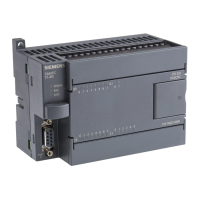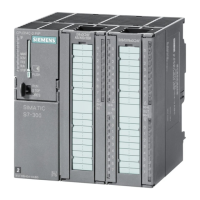Testing functions, Diagnostics and Fault Elimination
S7-300 Programmable Controller Hardware and Installation
A5E00105492-01
10-5
Diagnostic buffer
If an error occurs, the CPU writes the cause of error to the diagnostic buffer. In
STEP 7 you can read the diagnostic buffer with your PG. This location holds error
information in plain text.
Other modules capable of diagnostics can be equipped with their own diagnostic
buffer. In STEP 7 (HW Config > Hardware diagnostics) you can read out his buffer
on your PG.
Diagnostic-capable modules without diagnostic buffer write their error information
to the CPU's diagnostic buffer.
When an error or an interrupt event occurs, (e.g. time-of-day interrupt), the CPU
switches to STOP mode, or you can react in the user program via error/interrupt
OBs. This would be OB82 in the sample above.
Diagnostics with System Functions
The four most important options of diagnostics with system functions are listed
below:
• Using SFC 51 "RDSYSST" to read an SSL partial list or an extract thereof.
• Reading the diagnostic data (Slave diagnostics) of a DP slave, using SFC13
"DPNRM_DG"
Every DP slave provides slave diagnostic data according to EN 50 170 Volume
2, PROFIBUS. You can use SFC13 DPNRM_DG" to read these diagnostic
data. Error information is stored in hex code. Refer to the respective module
manual for information on the meaning of the read code.
For example, the entry of the value 50H (= dual 0101 0000) in byte 7 of the
slave diagnostics for the distributed I/O module ET 200B indicates a faulty fuse
or missing load voltage in channel group 2 and 3.
• Reading a data record with SFC59 "RD_REC"
You can use SFC59 "RD_REC" (read record) to read a specific data record
from the addressed module. Data records 0 and 1 are especially suitable for
reading diagnostic information from a diagnostic-capable module.
Data record 0 contains 4 bytes of diagnostic data describing the current state of
a signal module. Data record 1 contains the 4 bytes of diagnostic data also
stored in data record 0, plus module-specific diagnostic data.
• Reading out the start information of the current OB, using SFC6 "RD_SINFO"
Error information is also found in the start information of the respective error
OB.
You can use SFC6 "RD_SINFO" (read start information) to read the start
information of the OB that was last called and not yet processed completely,
and of the Startup OB that was last called.
10.4 Diagnostic options with STEP 7
The "Hardware diagnostics" function
Localize the cause of a module error by viewing the online information on the
module. You can localize the cause of an error in the user program cycle with the

